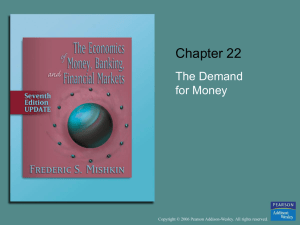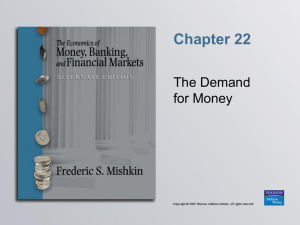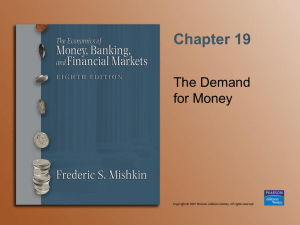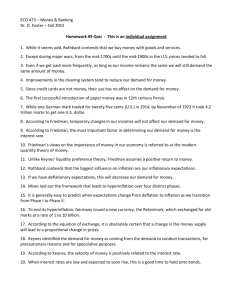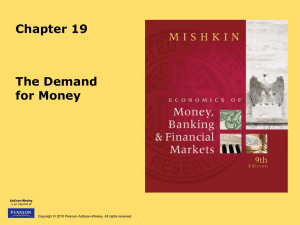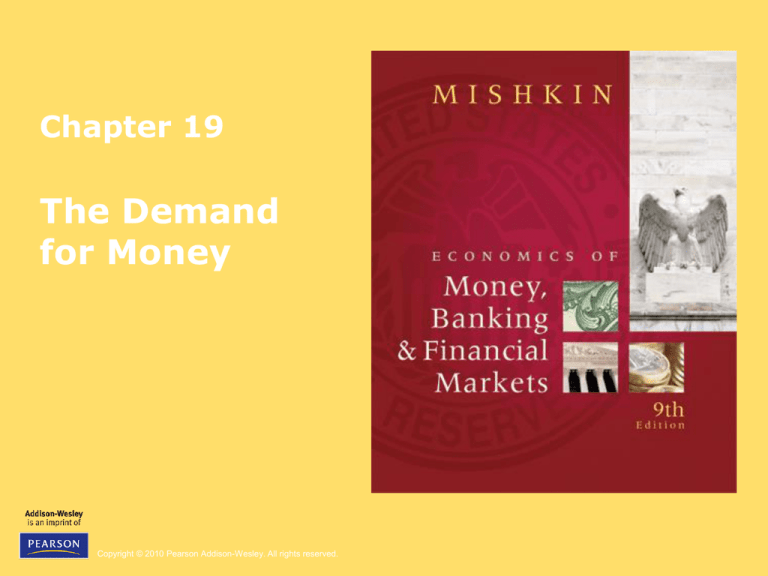
Chapter 19
The Demand
for Money
Copyright © 2010 Pearson Addison-Wesley. All rights reserved.
Quantity Theory of Money
• the quantity theory of money is a theory of how the
nominal value of aggregate income is determined.
Because it also tells us how much money is held for
a given amount of income, it is also a theory of the
demand for money.
• Velocity of Money and Equation of Exchange
• Irving Fisher examined the link between the total
quantity of money M (the money supply) and the
total amount of spending (P × Y), (aggregate
nominal income or nominal GDP.)
Copyright © 2010 Pearson Addison-Wesley. All rights reserved.
18-2
Velocity of Money and Equation of
Exchange
• The concept that provides the link between M and
(P × Y) is called the velocity of money, the rate of
turnover of money; or the average number of times
per year that a dollar is spent in buying the total
amount of goods and services produced in the
economy. Velocity V is defined as total spending (P
× Y) divided by the quantity of money M:
• V = (P × Y) l M
(1)
• e.g., if nominal GDP (P × Y ) = $5 billion and M =
$1 billion, velocity is 5, i.e., the average dollar is
spent five times in purchasing final goods and
services in the economy.
Copyright © 2010 Pearson Addison-Wesley. All rights reserved.
18-3
Velocity of Money and Equation of
Exchange
• By multiplying both sides by M, we obtain the
equation of exchange, which relates nominal income
to M and V (called the equation of exchange):
• M×V=P×Y
(2)
• The equation of exchange states that the quantity
of money multiplied by its velocity must be equal to
nominal income.
• Fisher reasoned that velocity is determined by the
institutions in an economy that affect the way
individuals conduct transactions. If people use less
cash (credit cards) to pay for their purchases V
increases.
Copyright © 2010 Pearson Addison-Wesley. All rights reserved.
18-4
Velocity of Money and Equation of
Exchange
• But if they pay using cash or checks, velocity
decreases.
• Fisher took the view that the institutional and
technological features of the economy would affect
velocity only slowly over time, so velocity would
normally be reasonably constant in the short run.
•
Copyright © 2010 Pearson Addison-Wesley. All rights reserved.
18-5
Quantity Theory
• Quantity Theory of money
• Because V is constant in the short run, the equation
of exchange states that nominal income is
determined solely by movements in M. When M
doubles, M × V doubles and so must P × Y,
• Classical economists (including Fisher) thought that
wages and prices were completely flexible, they
believed that the level of aggregate output Y
produced in the economy during normal times
would remain at the full-employment level, so Y in
the equation of exchange could also be treated as
reasonably constant in the short run.
Copyright © 2010 Pearson Addison-Wesley. All rights reserved.
18-6
Quantity Theory
• The quantity theory of money then implies that if M
doubles, P must also double in the short run,
because V and Y are constant.
• For the classical economists, movements in the
price level result solely from changes in the quantity
of money.
Copyright © 2010 Pearson Addison-Wesley. All rights reserved.
18-7
Quantity Theory of Money
Demand
• Because the quantity theory of money tells us how
much money is held for a given amount of
aggregate income, it is in fact a theory of the
demand for money.
• dividing both sides of the equation of exchange by
V, thus rewriting it as:
• M = (1/V) × PY
• Using k to represent the quantity 1/V (a constant,
because V is a constant), we can rewrite the
equation as:
• Md = k × PY
(3)
Copyright © 2010 Pearson Addison-Wesley. All rights reserved.
18-8
Quantity Theory of Money
Demand
• Equation 3 tells us that because k is a constant, the
level of transactions generated by a fixed level of
nominal income PY determines the quantity of
money Md that people demand.
• Therefore, Fisher’s quantity theory of money
suggests that the demand for money is purely a
function of income, and interest rates have no effect
on the demand for money.
Copyright © 2010 Pearson Addison-Wesley. All rights reserved.
18-9
Quantity Theory of Money
Demand
• The demand for money is determined
• (1) by the level of transactions generated by the
level of nominal income PY and
• (2) by the institutions in the economy that affect
the way people conduct transactions and thus
determine velocity and hence k.
Copyright © 2010 Pearson Addison-Wesley. All rights reserved.
18-10
Keynes’s Liquidity Preference Theory
• In his theory, the liquidity preference theory Keynes
asked the question: Why do individuals hold
money? He postulated that there are three motives
behind the demand for money: the transactions
motive, the precautionary motive, and the
speculative motive.
• Transactions Motive
• Primarily determined by the level of people’s
transactions, which is proportional to income, like
the classical economists, he took the transactions
component of the demand for money to be
proportional to income
Copyright © 2010 Pearson Addison-Wesley. All rights reserved.
18-11
Keynes’s Liquidity Preference Theory
• Precautionary Motive
• people hold money as a cushion against an
unexpected need, e.g., shop sales, an unexpected
bill, say for car repair or hospitalization.
• Keynes believed that the amount of precautionary
money balances people want to hold is determined
primarily by the level of transactions that they
expect to make in the future and that these
transactions are proportional to income
Copyright © 2010 Pearson Addison-Wesley. All rights reserved.
18-12
Keynes’s Liquidity Preference Theory
• Speculative Motive
• Keynes took the view that money is a store of
wealth and called this reason for holding money the
speculative motive.
• Keynes looked more carefully at the factors that
influence the decisions regarding how much money
to hold as a store of wealth, especially interest rates
• Keynes divided the assets that can be used to store
wealth into two categories: money and bonds.
• Keynes assumed that the expected return on money
was zero.
Copyright © 2010 Pearson Addison-Wesley. All rights reserved.
18-13
Keynes’s Liquidity Preference Theory
• For bonds, there are two components of the
expected return: the interest payment and the
expected rate of capital gains.
• Keynes assumed that individuals believe that
interest rates gravitate to some normal value (an
assumption less plausible in today’s world).
• If interest rates are below this normal value,
individuals expect the interest rate on bonds to rise
in the future and so expect to suffer capital losses
on them. As a result, individuals will be more likely
to hold their wealth as money rather than bonds,
and the demand for money will be high.
Copyright © 2010 Pearson Addison-Wesley. All rights reserved.
18-14
Keynes’s Liquidity Preference Theory
• when interest rates are above the normal value,
people will expect interest rates to fall, bond prices
to rise, and capital gains to be realized. At higher
interest rates, they are more likely to expect the
return from holding a bond to be positive, thus
exceeding the expected return from holding money.
They will be more likely to hold bonds than money,
and the demand for money will be quite low.
• Conclusion: as interest rates rise, the demand for
money falls, and therefore money demand is
negatively related to the level of interest rates.
Copyright © 2010 Pearson Addison-Wesley. All rights reserved.
18-15
Keynes’s Liquidity Preference Theory
• Putting the Three Motives Together
• The demand for real money balances is related to
real income Y and to interest rates i.
•
-
+
• Md/P= f ( i,Y )
• the demand for real money balances is negatively
related to the interest rate i, positively related to
real income Y.
• Is Velocity constant?
• Keynes’s theory of the demand for money implies
that velocity is not constant, but instead fluctuates
with movements in interest rates.
Copyright © 2010 Pearson Addison-Wesley. All rights reserved.
18-16
Keynes’s Liquidity Preference Theory
• Rewrite the liquidity preference equation
•
-
+
• P/Md=1/f (i, Y)
• Multiplying both sides of this equation by Y and
recognizing that Md can be replaced by M because
they must be equal in money market equilibrium,
we solve for velocity:
•
-
+
• V=PY/M=Ylf (i, Y)
• when i goes up, f (i,Y) declines, and V rises. A rise
in interest rates encourages people to hold lower
real money balances for a given level of income;
therefore V must be higher.
Copyright © 2010 Pearson Addison-Wesley. All rights reserved.
18-17
Keynes’s Liquidity Preference Theory
• The opposite is expected when interest rate goes
down.
• Keynes rejected the view that velocity could be
treated as a constant.
Copyright © 2010 Pearson Addison-Wesley. All rights reserved.
18-18
Further Developments in the
Keynesian Approach
• Transactions Demand
• William Baumol and James Tobin independently
developed similar demand for money models, which
demonstrated that even money balances held for
transactions purposes are sensitive to the level of
interest rates.
• They considered a hypothetical individual who
receives a payment once a period and spends it
over the course of this period, as shown in the
following graph.
Copyright © 2010 Pearson Addison-Wesley. All rights reserved.
18-19
FIGURE 2 Cash Balances in the
Baumol-Tobin Model
Copyright © 2010 Pearson Addison-Wesley. All rights reserved.
18-20
Keynes’s Liquidity Preference Theory
• The conclusion of the Baumol-Tobin analysis may be
stated as follows: As interest rates increase, the
amount of cash held for transactions purposes will
decline, which in turn means that velocity will
increase as interest rates increase. Put another
way, the transactions component of the demand
for money is negatively related to the level of
interest rates, i.e., the transactions demand for
money, and not just the speculative demand, will be
sensitive to interest rates.
Copyright © 2010 Pearson Addison-Wesley. All rights reserved.
18-21
Quantity Theory of Money
Demand
• Precautionary Demand
• As interest rates rise, the opportunity cost of
holding precautionary balances rises, and so the
holdings of these money balances fall. We then
have a result similar to the one found for the
Baumol-Tobin analysis. The precautionary demand
for money is negatively related to interest rates.
Copyright © 2010 Pearson Addison-Wesley. All rights reserved.
18-22
Friedman’s Modern Quantity
Theory of Money
• Instead of analyzing the specific motives for holding
money, as Keynes did, Friedman simply stated that
the demand for money must be influenced by the
same factors that influence the demand for any
asset. Friedman then applied the theory of asset
demand to money.
• The theory of asset demand indicates that the
demand for money should be a function of the
resources available to individuals (their wealth) and
the expected returns on other assets relative to the
expected return on money.
Copyright © 2010 Pearson Addison-Wesley. All rights reserved.
18-23
Friedman’s Modern Quantity Theory
of Money
• Friedman expressed his formulation of the demand
for money as follows:
+
-
-
-
• Md/P= f (Yp , rb - rm, re - rm, πe - rm)
• where Md/P = demand for real money balances
• Yp = Friedman’s measure of wealth, known as
permanent income
• Rm = expected return on money
• rb = expected return on bonds
• re = expected return on equity (common stocks)
• πe = expected inflation rate
Copyright © 2010 Pearson Addison-Wesley. All rights reserved.
18-24
Friedman’s Modern Quantity Theory
of Money
• money demand is positively related to Friedman’s
wealth concept, permanent income, which has much
smaller short-run fluctuations.
• Friedman categorized other assets into three:
bonds, equity, and goods.
• The incentives for holding these assets rather than
money are represented by the expected return on
each of these assets relative to the expected return
on money. As each relative return rises, the
demand for money will fall
Copyright © 2010 Pearson Addison-Wesley. All rights reserved.
18-25
Friedman’s Modern Quantity Theory
of Money
• Distinguishing Between the Friedman and Keynesian
Theories.
• Friedman recognized more than one interest rate in
his demand for money function, Keynes, lumped
financial assets other than money into one bonds
because he felt that their returns generally move
together.
• Friedman viewed money and goods as substitutes;
that is, people choose between them when deciding
how much money to hold.
• Friedman did not take the expected return on
money to be a constant, as Keynes did.
Copyright © 2010 Pearson Addison-Wesley. All rights reserved.
18-26
Friedman’s Modern Quantity Theory
of Money
• Unlike Keynes’s theory, which indicates that interest
rates are an important determinant of the demand
for money, Friedman’s theory suggests that
changes in interest rates should have little effect on
the demand for money, such that his money
demand equation can be approximated by:
• Md/p = f(Yp)
• Friedman stressed the stability of the demand for
money function and suggested that random
fluctuations in the demand for money are small and
that the demand for money can be predicted
accurately by the money demand function.
Copyright © 2010 Pearson Addison-Wesley. All rights reserved.
18-27
Friedman’s Modern Quantity Theory
of Money
• Velocity is highly predictable. We can see this by
writing down the velocity that is implied by the
money demand equation:
• V = Y/f (Yp )
• If we velocity is predictable, a change in the
quantity of money will produce a predictable change
in aggregate spending. Therefore, Friedman’s
theory of money demand is indeed a restatement of
the quantity theory, because it leads to the same
conclusion about the importance of money to
aggregate spending.
Copyright © 2010 Pearson Addison-Wesley. All rights reserved.
18-28

